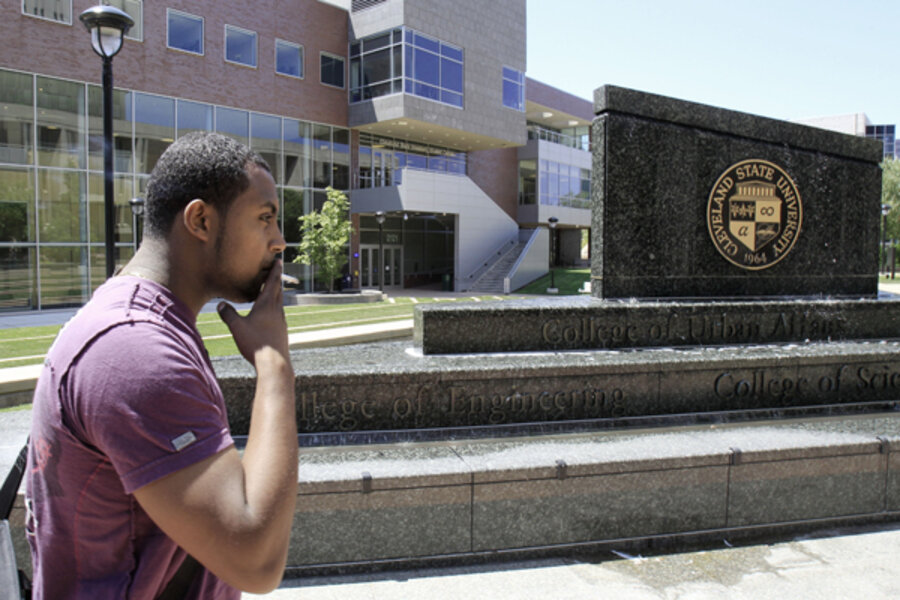Smoking bans: Tobacco-free college campuses on rise in US
Loading...
| WASHINGTON
The war on tobacco is going to college.
At a growing number of campuses nationwide, total bans on cigarettes and other tobacco products are showing up, barring students from lighting up anywhere on school grounds – even in the open air.
The most recent school system to snuff out campus tobacco was the Ohio public college system when the Board of Regents on Monday recommended an all-out prohibition on tobacco products. In June, the University System of Maryland announced its 12 institutions, inside and out, would go smoke-free by next July. Come September, the use and advertising of tobacco will be forbidden anywhere at schools within the City University of New York system.
Between January 2011 and this January, the number of US colleges and universities with total smoking bans rose from 466 to 648, according to the group Americans for Nonsmokers’ Rights. Already this year, 126 schools have moved forward with smoke-free policies that apply to all areas of campus.
“We hear from colleges they’re there to educate and raise the next generation of leaders, and that it’s the responsible thing to do,” says Bronson Frick, associate director of Americans for Nonsmokers’ Rights, based in Berkeley, Calif.
Some colleges have never allowed smoking for religious reasons. But about a decade ago, some that permitted it began to impose bans on indoor smoking that also governed – coinciding with similar workplace laws – how far from entrances smokers had to be. The concept of the smoke-free campus, which prohibits smoking even outside, marks the trend’s latest evolution.
In total, about 770 colleges are now smoke-free, according to Americans for Nonsmokers’ Rights. Some take that policy a step further by forbidding all forms of tobacco, including chewing tobacco. Because the organization relies on self-reported information, the actual number is probably higher, Mr. Frick says.
While exact data remains murky, one-third to one-half of colleges nationwide have likely implemented a policy or are weighing the option, says Ty Patterson, executive director of the National Center for Tobacco Policy, based in Springfield, Mo.
Policies barring smoking and tobacco have reached a “near tipping point,” says Mr. Patterson, who as the vice president of student affairs instituted one of the first smoke-free campuses in the country, at Ozarks Technical Community College in 2003.
The smoke-free movement on college campuses received a major boost in 2006 when a report by the US Surgeon General flagged secondhand smoke as risky at any exposure level, Patterson says.
The bans have not been without controversy, especially from smokers’ rights groups.
“Institutions for learning exist for the purpose of education, not indoctrination – especially where the students are of adult age,” wrote Audrey Silk, founder of New York Citizens Lobbying Against Smoker Harassment, in an email.
Some students are also questioning the role of universities to regulate completely legal behavior.
Audrey Imes, a junior at Ohio University in Athens, doubted whether the school could justifiably implement the Board of Regents’ proposed tobacco policy. When she smokes on campus, she says, it’s a personal decision.
“I have a right to be a smoker,” Ms. Imes says, adding that smoking would probably be pushed to the peripheries of campus, in places like bars and off-campus apartments.
But smokers are fighting an uphill battle.
The Board of Regents of the University System of Maryland green-lighted its policy out of a concern for the health dangers of smoking and a consensus that the smoking bans already in place at three of its colleges were a “nonissue,” USM spokesman Mike Lurie says.
“Presidents of institutions where a campus-wide ban had not been in place were looking with admiration at other campuses that had gone in that direction,” Mr. Lurie says.
About 45 million, or 19.3 percent, of all American adults smoke cigarettes, according to the Centers for Disease Control and Prevention. Out of 27,774 students surveyed at 44 two- and four-year colleges, 4.6 percent smoked every day in the past 30 days, a 2011 American College Health Association report found. About 14 percent smoked at least once in the past 30 days.
Under most of the bans, violations yield light, if any, punitive action. Repeat offenders sometimes face university disciplinary measures, which differ among schools.
Enforcement is usually not heavy-handed either. It mostly comes from the students themselves, many of whom just don’t want to be around cigarette smoke.
At the University of Kentucky in Lexington, a group of faculty and students, part of the Tobacco-Free Take Action volunteer group, approach smokers and request they put out their cigarette. They also offer resources to help the smoker quit.
“You have to create an environment where violating the policy just isn’t cool,” says Ellen Hahn, director of the Kentucky Center for Smoke-Free Policy, based in Lexington. “It’s not what’s expected.”
Kentucky has one of the highest rates of adult smoking in the county – 25 percent – and the campus ban has had a positive impact on efforts by some to quit. Since the ban, 11 campus tobacco users per month on average have sought to quit smoking, compared with 3 before the ban, Ms. Hahn says.





